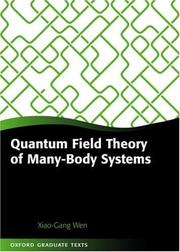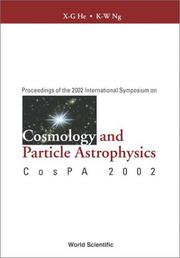| Listing 1 - 8 of 8 |
Sort by
|

ISBN: 128075902X 0191523968 1429459948 9780191523960 9781280759024 9781429459945 9780198530947 0198530943 9786610759026 6610759022 0198530943 Year: 2004 Publisher: Oxford New York Oxford University Press
Abstract | Keywords | Export | Availability | Bookmark
 Loading...
Loading...Choose an application
- Reference Manager
- EndNote
- RefWorks (Direct export to RefWorks)
This book is a pedagogical and systematic introduction to new concepts and quantum field theoretical methods in condensed matter physics, which may have an impact on our understanding of the origin of light, electrons and other elementary particles in the universe. Emphasis is on clear physical principles, while at the same time bringing students to the fore of today's research. - ;For most of the last century, condensed matter physics has been dominated by band theory and Landau's symmetry breaking theory. In the last twenty years, however, there has been the emergence of a new paradigm assoc
Quantum field theory. --- Many-body problem. --- n-body problem --- Problem of many bodies --- Problem of n-bodies --- Mechanics, Analytic --- Relativistic quantum field theory --- Field theory (Physics) --- Quantum theory --- Relativity (Physics)

ISBN: 128190631X 9786611906313 9812704906 9812382844 9789812382849 9789812704900 9781281906311 Year: 2003 Publisher: River Edge, N.J. World Scientific
Abstract | Keywords | Export | Availability | Bookmark
 Loading...
Loading...Choose an application
- Reference Manager
- EndNote
- RefWorks (Direct export to RefWorks)
The 2002 International Symposium on Cosmology and Particle Astrophysics (CosPA2002) was held from May 31 to June 2, 2002, in Taipei, Taiwan. The topics covered during the symposium included: (1) CMB Physics: SZ Surveys, Polarizations, Large-Scale Structures, Gravitational Lensing, and Data Analysis; (2) Dark Energy and Dark Matter: Dark Matter Physics, Quintessence and the Cosmological Constant; (3) Cosmology of Ultra High Energy Cosmic Rays; (4) Inflation and New Physics: Inflation, Noncommutative Geometry, Branes and Extra Dimensions. The proceedings have been selected for coverage in:. In
Book
ISBN: 1493990845 1493990829 Year: 2019 Publisher: New York, NY : Springer New York : Imprint: Springer,
Abstract | Keywords | Export | Availability | Bookmark
 Loading...
Loading...Choose an application
- Reference Manager
- EndNote
- RefWorks (Direct export to RefWorks)
This book approaches condensed matter physics from the perspective of quantum information science, focusing on systems with strong interaction and unconventional order for which the usual condensed matter methods like the Landau paradigm or the free fermion framework break down. Concepts and tools in quantum information science such as entanglement, quantum circuits, and the tensor network representation prove to be highly useful in studying such systems. The goal of this book is to introduce these techniques and show how they lead to a new systematic way of characterizing and classifying quantum phases in condensed matter systems. The first part of the book introduces some basic concepts in quantum information theory which are then used to study the central topic explained in Part II: local Hamiltonians and their ground states. Part III focuses on one of the major new phenomena in strongly interacting systems, the topological order, and shows how it can essentially be defined and characterized in terms of entanglement. Part IV shows that the key entanglement structure of topological states can be captured using the tensor network representation, which provides a powerful tool in the classification of quantum phases. Finally, Part V discusses the exciting prospect at the intersection of quantum information and condensed matter physics – the unification of information and matter. Intended for graduate students and researchers in condensed matter physics, quantum information science and related fields, the book is self-contained and no prior knowledge of these topics is assumed.
Quantum computing. --- Computation, Quantum --- Computing, Quantum --- Information processing, Quantum --- Quantum computation --- Quantum information processing --- Electronic data processing --- Quantum theory. --- Quantum Information Technology, Spintronics. --- Condensed Matter Physics. --- Quantum Physics. --- Quantum Computing. --- Quantum dynamics --- Quantum mechanics --- Quantum physics --- Physics --- Mechanics --- Thermodynamics --- Quantum computers. --- Spintronics. --- Condensed matter. --- Quantum physics. --- Condensed materials --- Condensed media --- Condensed phase --- Materials, Condensed --- Media, Condensed --- Phase, Condensed --- Liquids --- Matter --- Solids --- Fluxtronics --- Magnetoelectronics --- Spin electronics --- Spinelectronics --- Microelectronics --- Nanotechnology --- Computers
Book
ISBN: 9811548676 9811548668 Year: 2020 Publisher: Springer Singapore
Abstract | Keywords | Export | Availability | Bookmark
 Loading...
Loading...Choose an application
- Reference Manager
- EndNote
- RefWorks (Direct export to RefWorks)
This book systematically discusses the basic concepts, theories, research and latest trends in image fusion. It focuses on three image fusion categories – pixel, feature and decision – presenting various applications, such as medical imaging, remote sensing, night vision, robotics and autonomous vehicles. Further, it introduces readers to a new category: edge-preserving-based image fusion, and provides an overview of image fusion based on machine learning and deep learning. As such, it is a valuable resource for graduate students and scientists in the field of digital image processing and information fusion.
Optical data processing. --- Image Processing and Computer Vision. --- Optical computing --- Visual data processing --- Bionics --- Electronic data processing --- Integrated optics --- Photonics --- Computers --- Optical equipment
Digital
ISBN: 9781493990849 Year: 2019 Publisher: New York, NY Springer
Abstract | Keywords | Export | Availability | Bookmark
 Loading...
Loading...Choose an application
- Reference Manager
- EndNote
- RefWorks (Direct export to RefWorks)
This book approaches condensed matter physics from the perspective of quantum information science, focusing on systems with strong interaction and unconventional order for which the usual condensed matter methods like the Landau paradigm or the free fermion framework break down. Concepts and tools in quantum information science such as entanglement, quantum circuits, and the tensor network representation prove to be highly useful in studying such systems. The goal of this book is to introduce these techniques and show how they lead to a new systematic way of characterizing and classifying quantum phases in condensed matter systems. The first part of the book introduces some basic concepts in quantum information theory which are then used to study the central topic explained in Part II: local Hamiltonians and their ground states. Part III focuses on one of the major new phenomena in strongly interacting systems, the topological order, and shows how it can essentially be defined and characterized in terms of entanglement. Part IV shows that the key entanglement structure of topological states can be captured using the tensor network representation, which provides a powerful tool in the classification of quantum phases. Finally, Part V discusses the exciting prospect at the intersection of quantum information and condensed matter physics – the unification of information and matter. Intended for graduate students and researchers in condensed matter physics, quantum information science and related fields, the book is self-contained and no prior knowledge of these topics is assumed.
Quantum mechanics. Quantumfield theory --- Statistical physics --- Matter physics --- Spectrometric and optical chemical analysis --- Computer. Automation --- EMI (electromagnetic interference) --- quantumfysica --- materie (fysica) --- quantummechanica --- electron spin resonance spectre --- quantumtheorie --- quantumcomputers --- informatietechnologie
Book
ISBN: 9781493990849 Year: 2019 Publisher: New York, NY Springer New York :Imprint: Springer
Abstract | Keywords | Export | Availability | Bookmark
 Loading...
Loading...Choose an application
- Reference Manager
- EndNote
- RefWorks (Direct export to RefWorks)
Quantum mechanics. Quantumfield theory --- Statistical physics --- Matter physics --- Spectrometric and optical chemical analysis --- Computer. Automation --- EMI (electromagnetic interference) --- quantumfysica --- materie (fysica) --- quantummechanica --- electron spin resonance spectre --- quantumtheorie --- quantumcomputers --- informatietechnologie
Multi
ISBN: 9789811548673 Year: 2020 Publisher: Singapore Springer Nature Singapore :Imprint: Springer
Abstract | Keywords | Export | Availability | Bookmark
 Loading...
Loading...Choose an application
- Reference Manager
- EndNote
- RefWorks (Direct export to RefWorks)
This book systematically discusses the basic concepts, theories, research and latest trends in image fusion. It focuses on three image fusion categories – pixel, feature and decision – presenting various applications, such as medical imaging, remote sensing, night vision, robotics and autonomous vehicles. Further, it introduces readers to a new category: edge-preserving-based image fusion, and provides an overview of image fusion based on machine learning and deep learning. As such, it is a valuable resource for graduate students and scientists in the field of digital image processing and information fusion.
Electronics --- Telecommunication technology --- Computer. Automation --- optische communicatie --- optische elektronica --- datacommunicatie
Digital

ISBN: 9783112495605 9783112495599 Year: 2022 Publisher: Berlin ;; Boston De Gruyter
Abstract | Keywords | Export | Availability | Bookmark
 Loading...
Loading...Choose an application
- Reference Manager
- EndNote
- RefWorks (Direct export to RefWorks)
| Listing 1 - 8 of 8 |
Sort by
|

 Search
Search Feedback
Feedback About UniCat
About UniCat  Help
Help News
News